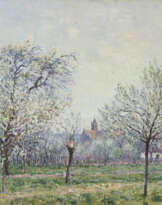ID 1177499
Lot 7 | Alfred Sisley (1839-1899)
Estimate value
€ 400 000 – 600 000
Les Coteaux de La Celle, après Saint-Mammès
signé et daté 'Sisley. 84' (en bas à droite)
huile sur toile
53.7 x 65 cm.
Peint en 1884
signed and dated 'Sisley. 84' (lower right)
oil on canvas
21 1⁄8 x 25 ½ in.
Painted in 1884
Provenance
Maurice Allard du Chollet, Paris.
Bollag Galleries, Zurich.
M. Knœdler & Company, New York (acquis auprès de celle-ci en août 1923).
Evan Edward Chateris, Londres (acquis auprès de celle-ci le 30 avril 1928)
Collection particulière, Suisse (en juillet 1938).
Puis par descendance au propriétaire actuel.
Literature
F. Daulte, Alfred Sisley, Catalogue raisonné de l'œuvre peint, Lausanne, 1959, no. 558 (illustré).
F. Daulte, Sisley, Les Saisons, Paris, 1992, p. 61, no. 34 (illustré en couleurs).
S. Brame et F. Lorenceau, Alfred Sisley, Catalogue critique des peintures et des pastels, Paris, 2021, p. 226 et 469, no. 570 (illustré en couleurs, p. 226 et 469).
Exhibited
Paris, Galeries Georges Petit, Exposition d'œuvres de Alfred Sisley, mai-juin 1917, no. 40 (titré 'Les Bateaux de La Celle après Saint-Mammès').
New York, M. Knœdler & Company, Exhibition of the last Fifty Years in French art, janvier 1927, no. 21 (titré 'The Banks of the River').
Columbus, The Colombus Gallery of Fine Arts, Paintings belonging to Mr. Derek Jackson of Lausanne, Switzerland, 1957 (illustré).
Lausanne, Fondation de l'Hermitage, L'Impressionnisme dans les collections romandes, juin-octobre 1984, no. 100 (illustré en couleurs).
Further details
En 1880, Sisley se voit contraint, pour des raisons financières, de quitter Sèvres et de s’installer non loin de Paris, dans la région de Moret-sur-Loing en lisière de la forêt de Fontainebleau. L’artiste renoue alors avec ses années de jeunesse durant lesquelles il s’est formé dans cette forêt aux côtés des autres impressionnistes, Monet, Renoir et Bazille. À partir de ce moment et jusqu'à sa mort, en 1899, les paysages paisibles de cette région "deviennent tout son univers" (Alfred Sisley, poète de l’impressionnisme, cat. exp., Musée des Beaux-arts, Lyon, 2002-2003, p. 32).
Dans les années 1880, Sisley s’adonne aux séquences, en appliquant le principe impressionniste de manière encore plus systématique. Il représente un endroit spécifique dans une série de compositions où seul le point d’observation varie légèrement. Les bords de la Seine et les écluses du canal du Loing, près de Saint-Mammès, deviennent alors un motif récurrent.
La construction de ses paysages des années 1880, dont font partie les présents Coteaux de La Celle, après Saint-Mammès, est souvent assez similaire. Sisley y fait davantage ressortir la structure en privilégiant une ligne d’horizon très basse, avec une importance laissée au ciel et au premier plan, fait d'eau et d’herbe. Le cours d’eau créant une diagonale est un procédé traditionnellement utilisé pour mettre en place la représentation de paysage. L’organisation spatiale rigoureuse est toutefois contrebalancée par une spontanéité d’exécution et une touche dynamique et vibrante. Toute la toile est animée par un réseau de touches vigoureuses et denses, de texture extrêmement variée. Ces touches pourraient être rattachées aux expérimentations néo-impressionnistes de Pissarro et Seurat (qui montre sa Baignade à Asnières lors de la première exposition du Salon des Indépendants en 1884).
Enfin, dans Les Coteaux de La Celle, après Saint-Mammès, Silsey parvient ici encore à réchauffer la gamme froide des bleus et verts par des touches de jaune et d’orange qui animent ce paysage printanier si paisible.
In 1880, for financial reasons, Sisley was forced to leave Sèvres and settle not far from Paris, in the Moret-sur-Loing region on the edge of the Fontainebleau forest. Here, the artist reconnected with his youth, during which he had trained in the forest alongside the other Impressionists, Monet, Renoir and Bazille. From then until his death in 1899, the peaceful landscapes of this region "became his whole world" (Alfred Sisley, poète de l'impressionnisme, cat. exp., Musée des Beaux-arts, Lyon, 2002-2003, p. 32).
In the 1880s, Sisley turned to sequences, applying the Impressionist principle even more systematically. He represented a specific place in a series of compositions in which only the point of observation varied slightly. The banks of the Seine and the locks of the Canal du Loing, near Saint-Mammès, became a recurring motif.
The construction of his landscapes of the 1880s, which include the present Les Coteaux de La Celle, après Saint-Mammès, is often quite similar. Here, Sisley emphasised the structure by favouring a very low horizon, with the sky and the foreground of water and grass taking centre stage. The watercourse creating a diagonal is a process traditionally used to set up the representation of landscape. However, the rigorous spatial organisation is counterbalanced by a spontaneity of execution and a dynamic, vibrant brushstroke. The entire canvas is animated by a network of vigorous, dense strokes of extremely varied texture. These brushstrokes could be related to the neo-Impressionist experiments of Pissarro and Seurat (who showed his Baignade à Asnières at the first Salon des Indépendants exhibition in 1884).
Finally, in Les Coteaux de La Celle, après Saint-Mammès, Silsey once again managed to warm up the cold range of blues and greens with touches of yellow and orange that enliven this peaceful spring landscape.
| Artist: | Alfred Sisley (1839 - 1899) |
|---|---|
| Applied technique: | Oil on canvas |
| Auction house category: | Paintings, Watercolors, Drawings, Paintings |
| Artist: | Alfred Sisley (1839 - 1899) |
|---|---|
| Applied technique: | Oil on canvas |
| Auction house category: | Paintings, Watercolors, Drawings, Paintings |
| Address of auction |
CHRISTIE'S 9 Avenue Matignon 75008 Paris France | ||||||||||||||
|---|---|---|---|---|---|---|---|---|---|---|---|---|---|---|---|
| Preview |
| ||||||||||||||
| Phone | +33 (0)1 40 76 85 85 | ||||||||||||||
| Fax | +33 (0)1 40 76 85 86 | ||||||||||||||
| Conditions of purchase | Conditions of purchase | ||||||||||||||
| Shipping |
Postal service Courier service pickup by yourself | ||||||||||||||
| Payment methods |
Wire Transfer | ||||||||||||||
| Business hours | Business hours
|
















